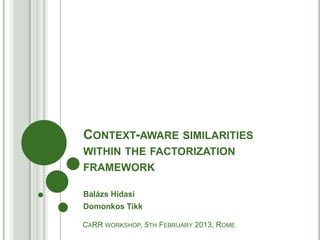
Context-aware similarities within the factorization framework - presented at CARR 2013
- 1. CONTEXT-AWARE SIMILARITIES WITHIN THE FACTORIZATION FRAMEWORK Balázs Hidasi Domonkos Tikk CARR WORKSHOP, 5TH FEBRUARY 2013, ROME
- 2. OUTLINE Background & scope Levels of CA similarity Experiments Future work
- 3. BACKGROUND Implicit feedback Context I2I Factorization recommendation This work
- 4. IMPLICIT FEEDBACK User preference not coded explicitely in data E.g. purchase history Presence preference assumed Absence ??? Binary „preference” matrix Zeroes should be considered Optimize for Weighted RMSE Partial ordering (ranking)
- 5. CONTEXT Can mean anything Here: event context User U has an event on Item I while the context is C E.g.: time, weather, mood of U, freshness of I, etc. In the experiments: Seasonality (time of the day or time of the week) Time period: week / day
- 6. FACTORIZATION I Preference data can be organized into matrix Size of dimensions high Data is sparse Approximate this matrix by the product of two low rank matrices Each item and user has a feature vector Predicted preference is the scalar product of the item appropriate vectors user r T r Uu Ii u ,i Here we optimize for wRMSE (implicit case) Learning features with ALS
- 7. FACTORIZATION II. Context introduced additional context dimension Matrix tensor (table of records) Models for preference prediction: item Elementwise product model Weighted scalar product user r T ru , i , c 1 (U u I i C c ) Pairwise model Context dependent user/item bias T T T ru , i , c Uu Ii Uu Cc Ii Cc context context item + + user user item r
- 8. ITEM-TO-ITEM RECOMMENDATIONS Items similar to the current item E.g.: user cold start, related items, etc. Approaches: association rules, similarity between item consumption vectors, etc. In the factorization framework: Similarity between the feature vectors T Scalar product: s i , j Ii I j T Ii Ij Cosine similarity: s i , j Ii 2 Ij 2
- 9. SCOPE OF THIS PROJECT Examination wether item similarities can be improved using context-aware learning or prediction compared to the basic feature based solution Motivation: If factorization models are used anyways, it would be good to use them for I2I recommendations as well Out of scope: Comparision with other approaches (e.g. association rules)
- 10. CONTEXT-AWARE SIMILARITIES: LEVEL1 The form of computing similarity remains T si, j Ii Ij Ii T Ij si, j Ii 2 Ij 2 Similarity is NOT CA Context-aware learning is used Assumption: item models will be more accurate Reasons: during the learning context is modelled separately Elementwise product model Context related effects coded in the context feature vector Pairwise model Context related biases removed
- 11. CONTEXT-AWARE SIMILARITIES: LEVEL2 Incorporating the context features Elementwise product model Similarities reweighted by the context feature Assumption: will be sensitive to the quality of the context T si , j ,c T 1 Ii Cc I j 1 Ii Cc I j s i , j ,c Pairwise model Ii 2 Ij 2 Context dependent promotions/demotions for the participating items Assumption: minor improvements to the basic similarity T T T s i , j ,c Ii Ij Ii Cc Ij Cc
- 12. CONTEXT-AWARE SIMILARITIES: LEVEL2 NORMALIZATION Normalization of context vector Only for cosine similarity Elementwise product model: Makes no difference in the ordering Recommendation in a given context to a given user Pairwise model Might affect results Controls the importance of item promotions/demotions T T T Ii Ij Ii Cc Ij Cc s i , j ,c Ii Ij Ii 2 Ij 2 2 2 T T T Ii Ij Ii Cc Ij Cc s i , j ,c Ii Ij Ii 2 Cc 2 Ij Cc 2 2 2 2
- 13. EXPERIMENTS - SETUP Four implicit dataset LastFM 1K – music TV1, TV2 – IPTV Grocery – online grocery shopping Context: seasonality Both with manually and automatically determined time bands Evaluation: recommend similar items to the users’ previous item Recall@20 MAP@20 Coverage@20
- 14. EXPERIMENTS - RESULTS Improvement for Grocery Improvement for LastFM 35.00% 200.00% 183.91% 29.40% 30.00% 150.00% 25.00% 21.40% 20.00% Recall 100.00% Recall 15.00% 12.90% Coverage Coverage 10.00% 50.00% 6.11% 6.79% 6.14% 17.99%19.72% 5.14% 5.83% 3.91% 3.53% 5.27% 5.00% 0.87% 0.00% 0.00% -7.92% -1.62% -3.18% -18.26% -21.96% -50.00% Improvement for TV1 Improvement for TV2 900.00% 797.51% 20.00% 800.00% 0.91% 0.79% 0.00% 0.59% 700.00% -0.23% -3.23% 600.00% -20.00% -8.08% -8.13% -10.40% 500.00% Recall Recall 400.00% -40.00% Coverage -37.24% Coverage 300.00% -60.00% 200.00% 7.34% 46.40% 100.00% 0.69% 8.31% 1.77% 6.77% 5.89% 4.86% -80.00% 0.00% -82.32% -3.53% -100.00% -100.00% From left to right: L1 elementwise, L1 pairwise, L2 elementwise, L2 pairwise, L2 pairwise (norm)
- 15. EXPERIMENTS - CONCLUSION Context awareness generally helps Impromevent greatly depends on method and context quality All but the elementwise level2 method: Minor improvements Tolerant of context quality Elementwise product level2: Possibly huge improvements Or huge decrease in recommendations Depends on the context/problem
- 16. (POSSIBLE) FUTURE WORK Experimentation with different contexts Different similarity between feature vectors Predetermination wether context is useful for User bias Item bias Reweighting Predetermination of context quality Different evaluation methods E.g. recommend to session
- 17. THANKS FOR THE ATTENTION! For more of my recommender systems related research visit my website: http://www.hidasi.eu
